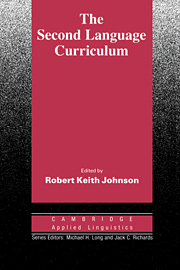Book contents
- Frontmatter
- Contents
- Contributors
- Series editors' preface
- Acknowledgements
- Overview
- I 1 CURRICULUM OVERVIEW
- I 2 CURRICULUM PLANNING
- II ENDS/MEANS SPECIFICATION
- III PROGRAMME IMPLEMENTATION
- Chapter 7 Faculty development for language programs
- Chapter 8 The evolution of a teacher training programme
- Chapter 9 Appropriate design: the internal organisation of course units
- Chapter 10 Beyond language learning: perspectives on materials design
- IV CLASSROOM IMPLEMENTATION
- V EVALUATION
- Bibliography
- Index
Chapter 8 - The evolution of a teacher training programme
Published online by Cambridge University Press: 05 October 2012
- Frontmatter
- Contents
- Contributors
- Series editors' preface
- Acknowledgements
- Overview
- I 1 CURRICULUM OVERVIEW
- I 2 CURRICULUM PLANNING
- II ENDS/MEANS SPECIFICATION
- III PROGRAMME IMPLEMENTATION
- Chapter 7 Faculty development for language programs
- Chapter 8 The evolution of a teacher training programme
- Chapter 9 Appropriate design: the internal organisation of course units
- Chapter 10 Beyond language learning: perspectives on materials design
- IV CLASSROOM IMPLEMENTATION
- V EVALUATION
- Bibliography
- Index
Summary
Introduction
This paper provides an account of an in-service programme for teachers of English as a foreign language in secondary schools in a European country. The programme was initiated in 1978 and is still in operation. The authors have been the training team throughout the programme, although they have been supported from time to time by certain specialists. During the eight-year period between 1978 and 1985 well over a hundred experienced teachers have participated, and they have had a significant influence upon the nature of the evolution described in this paper.
The paper has three purposes: i) to provide a description of the main characteristics of the in-service programme; ii) to offer an account of the ways in which the programme has developed, particularly with regard to changes in the priorities, roles, and activities of trainers and trainees; and iii) to deduce a number of principles for in-service training from our experience of the programme which may be of interest and value to others engaged in in-service work.
We believe the programme may be unusual in its coincidence of eight specific characteristics:
It is a long-term experience and therefore facilitates a cyclic process from training input, through trainee implementation in the classroom, to subsequent feedback and later training input in response to classroom experiences.
A main source of continuity in the programme has been the presence of the same four trainers throughout.
- Type
- Chapter
- Information
- The Second Language Curriculum , pp. 111 - 135Publisher: Cambridge University PressPrint publication year: 1989
- 12
- Cited by



